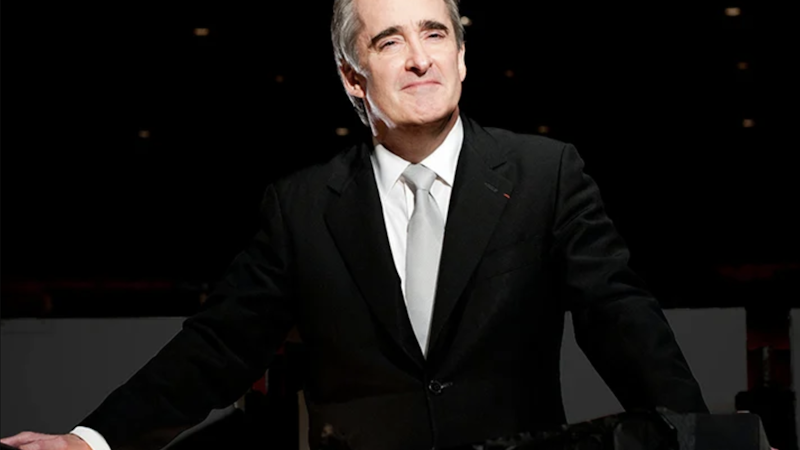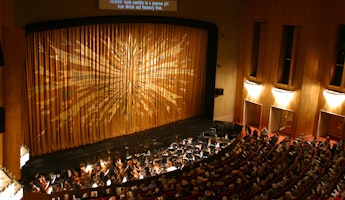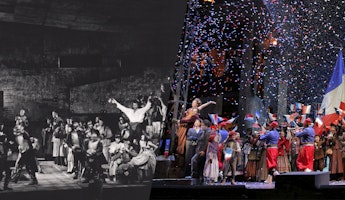Blog
August 31, 2021
Verdi and Azucena Proved Them Wrong

“Everyone cried out at the idea of putting a hunchback on the stage; well, there you are. I was very happy to write Rigoletto…and it is my best opera.” —Giuseppe Verdi
BREAKING CONVENTIONS
In Rigoletto, Verdi saw his opportunity to turn convention on its head by depicting a noble ruler as immoral and his court jester, a hunchback, as a character of depth. In the minds of Verdi's contemporaries, a deformed man was considered unworthy of the stage, certainly not as a tragic protagonist. Verdi presented just that tragic protagonist in Rigoletto.
After that, attacking another societal prejudice, Verdi challenged the public’s view that a Romani* woman could only appear on stage to tell fortunes and dance. But Verdi brought this tormented soul to center stage and into her into a tragic heroine.
The result? Il Trovatore, one of the world’s most popular operas, one which has never been absent from the world stage since its triumphant premiere in 1853. Both Verdi and Antonio García Gutiérrez, the author of the original Spanish play El Trovador, were born in 1813, several months apart. The play launched García Gutiérrez’s career and the opera reaffirmed Verdi’s already preeminent status.
The opera checks off every box an opera lover could ask for: one inspired melody after another, vibrant rhythmic thrust, a hit parade of vehicles for operatic vocalism, four full scenas with cabalettas, high notes in quantity. Human emotions abound, love, hate, yearning, ecstatic joy (in small doses), vengeance, violence, murder and death. Its story resonates with themes that are on our minds today: the struggles of a disenfranchised woman, the sting of racism, and the long-term effects of post-traumatic stress disorder.
On the negative side of the ledger, its critics are many. The leading complaints are of an incomprehensible story line, melodramatic hyperbole and overall absurdity of its plot. But who says life and history are free from absurdity? There are those who feel our very existence is absurd. If one attentively reads the story, it is not incomprehensible. As for barely credible stories, our world thrives on them, and they can be found everywhere; just look at social media. Hyperbole? Opera is a larger-than-life art form that thrives on extravagance of feeling. Written in the era of melodrama, Il Trovatore makes a case par excellence for what that word suggests: “melos,” Greek for melody, and drama.
So, Il Trovatore has lived its almost 175-year existence simultaneously loved and disparaged. It has been a convenient whipping boy for critics, writers, musicologists and musicians who don’t like opera. Parodies started early, from Gilbert and Sullivan (who quoted the Anvil Chorus in The Pirates of Penzance) leading the way to the Marx Brothers’ 1935 cinematic romp, A Night at the Opera.
I do understand the problems with Il Trovatore as a theatrical piece. But I do not at all subscribe to the view that it is risible or nonsensical. On the contrary, it is an audacious opera, based on an equally daring play. For the young playwright it was a ticket to lifelong notoriety and for the only slightly older (not yet 40) composer, it was part of the crowning achievement of what would represent not even the halfway mark in an extraordinary compositional career. One 20th-century Italian critic wrote that Verdi’s “genius is positively crackling!”
The plot has much to offer the contemporary sensibility. It's an opera whose protagonist (not the troubadour of the title) is one whose story reflects many ugly truths, still relevant today, about the era of its creators. The unmistakable influence of Victor Hugo, France’s 19th-century literary giant of Romanticism, stands behind both García Gutiérrez and Verdi. Hugo’s enunciation of the concept of the proximity of the sublime and the grotesque was one of his many great contributions. It was lost on neither the composer nor the playwright. Hugo’s Triboulet (whom Verdi transformed into Rigoletto) and Quasimodo exemplify this union.
AZUCENA AS PROTAGONIST
“Sublime and grotesque” is an apt description of the opera’s protagonist: Azucena, a Romani woman in medieval Spain. That she is the protagonist is not just my opinion, but Verdi’s. It seems that it was his original intention to make her the prima donna and to name the opera after her. “First of all, the zingara [a now unacceptable pejorative term for members of the Roma race] ... she is a woman of rare character who will give her name to the opera,” Verdi wrote. She shares her name with a white lily, a sharp contrast to her hideous, disheveled and dirty appearance. She is a sinister feminine counterpart to Triboulet and Quasimodo and her story deals with racism and lifelong post-traumatic stress disorder. She is a rich and complex character, worthy of serious study, not of ridiculing banter amongst opera aficionados. She is the most original character in the play and exactly the type of “Hugo-esque” antihero that excites Verdi’s muse.
It should immediately be noted that Azucena occupies a unique position in Verdi’s output. The mother, as a leading character, is almost totally absent from Verdi’s output. The warm and supportive Alice Ford in Falstaff is the only other significant mother in Verdi’s work. Azucena is a tragic mother, the daughter of another tragic mother, and someone who clearly had Verdi's sympathy. Her greatest strengths are her devotion to both her mother and her son. At the same time, she is drawn and incited to vengeance, perhaps out of a belief that her mother’s death and injunction obliges her.
To appreciate how unique Azucena is, we must remember that the plight of the tragic father is a recurring and fundamental theme in Verdi’s operas from the beginning to the end of his career. The relationships between Verdi’s fathers and sons are almost always conflictual, his fathers and daughters slightly less so, but all those relationships are lived in the absence of a mother figure. Although I do not believe that operas and symphonies are necessarily autobiographical (particularly in Verdi’s case), it is worth noting that he was in a period of mourning when he was conceptualizing Il Trovatore, as his mother had passed away in 1851.
Leaving aside that Manrico is her adopted son, Azucena is fully invested in their relationship, and he is devoted to her until the end. The only (momentary) discord between them is prompted by Manrico’s sudden departure to prevent Leonora from entering the convent. And he will (equally abruptly) abandon Leonora at the altar to save his mother. This is paradigmatic of his fundamental conflict, between filial and erotic love.
VERDI AND THE MIDDLE-PERIOD MASTERPIECES
The middle-period trilogy of Verdi masterpieces (a posthumous term) consists of Rigoletto (premiered on March 11, 1851), Il Trovatore (January 19, 1853) and La Traviata (March 6, 1853). I cite the dates of the premieres to underscore the fact that Verdi wrote them in an astonishingly short time, two of them virtually simultaneously. The music is so clearly etched that each opera resembles itself more than its next of kin although one can easily identify close similarities. Like the head of Janus, these works look backward and forwards. Oversimplified, Rigoletto and La Traviata point forward as if to inaugurate the future, whereas Il Trovatore is the crowning achievement of the past, a culmination of the Verdian melodrama par excellence of the preceding 14 years. That Trovatore and Traviata, written so closely together, are as different as they are, is remarkable. Trovatore’s brand of romanticism is a culmination and summation of his earlier operas.
Explanations for their durability are in no short supply. First: the seemingly unflagging inspiration of melodic invention. These operas abound in arias and duets whose melodies could be grasped immediately by the public, whistled, hummed and sung on a popular level, and admired and studied after multiple hearings by musicians and musicologists. Their “formula” was simple, even simplistic, but the genius of how they spoke directly from the heart of the character on stage to the emotions of the listener is the quintessence of Italian opera. And the vocal demands are enormous, hence the famous tongue-in-cheek remark, usually attributed to Enrico Caruso: “A successful performance of Il Trovatore is relatively easy. All that is needed are the four greatest singers in the world.”
Verdi’s muse was excited by sympathetic portrayals of humanity’s underdogs. This trio of masterpieces didn't burst forth from nowhere; they had been percolating over time and he cut a path in his two previous operas. Luisa Miller (1849) is the tragedy of the genuine goodness of the humble trampled upon by the aristocracy. Stiffelio (1850), the opera that directly precedes Rigoletto, portrays a minister’s struggle with an adulterous wife and her lover. The common thread that weaves through these works is the presentation of protagonists who belong to categories of society’s cast-offs and outsiders. In the context of Italian theater of the early 1850s, this was not just daring, bold and shocking, but revolutionary.
Verdi saw the potential for explosive dramatic material in the lives and fates of Rigoletto, a misanthropic, hunchbacked jester; La Traviata’s Violetta, a Parisian sex worker (politely referred to as a courtesan) and Azucena, a tragically crazed Roma woman (whose race numbered over a million victims of the Nazi genocides, and is still and marginalized today)
The success of these three operas resides not only in the genius of Verdi’s music, but in his dramatic instinct in choosing subjects. The protagonists’ bracing contradiction of good and evil, love and hate, beauty and ugliness, enriched the contemporary scene with its overabundance of cardboard characters.
Verdi’s theatrical instinct led him ceaselessly to search for interesting dramatic material. Europe had been rocked by political upheaval and revolution in 1848, and the composer keenly felt the shock waves. His lifelong pursuit of popular appeal led him to eschew much of the formulaic opera libretti of the previous century. He forswore mythology, ancient Greece, Rome and even Italian subjects. French, English, German and Spanish sources abound, and it is from Victor Hugo, Antonio García Gutiérrez and Alexandre Dumas that he found the sources for this extraordinary trilogy.
SHIFTING SHADES OF MORALITY
Azucena and Rigoletto are kindred in their moral ambiguity. Whatever their faults and misdeeds are, both win our sympathy because of their love for their children. We forgive Rigoletto’s misanthropy and moral ugliness, because he tenderly loves his daughter Gilda. Azucena’s story engenders our pity not just because of the horror of her mother’s burning at the stake, a trauma she has lived with her entire adult life, but primarily because she loves Manrico as a son. All of this makes us overlook that she is a murderer—and of a child at that. Both are tragic because they cause the death of their beloved children. (For Azucena, this is true both for her biological child and her adopted son.) Verdi allows Rigoletto and Azucena to point an accusatory finger at their societies for their abject existences. He also takes his own society to task. In the minds of Verdi's contemporaries, hunchbacks and dwarfs were for circuses or the courts of kings, not for the operatic stage, and the inner struggles of Romas were of no interest to the Italian public.
MAKING SENSE OF THE STORY
The intricate drama of Il Trovatore is not as ridiculous as has been commonly claimed. Yes, it is unusual, to say the least, for a woman to mix up her own baby with another and throw him into the flames. But given the trauma Azucena had just endured—seeing her mother burned at the stake as a witch— it’s within the realm of the possible.
The opera is complicated because there are two different plots, revolving around the two women. They, and their stories, exist independently of each other, and intersect only at the end.
Plot I: Azucena, a poor Roma woman, whose mother was burned at the stake as a witch, lives with her dying mother’s injunction to avenge her. She attempts to do so by murdering the infant son of the old Count di Luna, but in a moment of confusion (and this is from where 90% of Trovatore-related humor derives) she throws her own baby in the fire. These events take place some 20 years before the opera begins and are recounted piecemeal in the first two acts. Azucena adopts the Count’s infant son and brings him up in ignorance of his origins, hoping he will eventually kill the Count’s other remaining son and thus avenge her own mother.
Plot II: The noblewoman Leonora is wooed by two men: Manrico, a mysterious troubadour knight, and the Count di Luna, son of the old “good” Count di Luna and brother to the presumed-deceased baby. Leonora loves Manrico and rejects the Count, and a bitter rivalry now exists between the two men. Leonora will eventually take her own life, rather than live with the Count, in an unsuccessful attempt to save Manrico.
The attentive listener will have heard the whole story and could piece it together out of the embers (as it were) as early as Act Two, but the full truth will only become manifest to the only survivor at the end, the young Count di Luna. He is fated to live with the consequences of his actions for the rest of his life.
As the second story revolving around Leonora develops, she becomes a counterweight to Azucena. They never meet and are on stage together only at the end of the opera. Leonora is noble, intelligent and determined. The Count’s jealousy is fueled by class distinctions and politics: Leonora’s preference for a troubadour (someone of inferior rank) upsets his world view and insults his pride. Adding insult to injury, Manrico and the Count fight on opposing sides of a civil war. Nurtured by a sense of entitlement, the Count cannot endure that Leonora would rather enter a convent than marry him.
CHARACTERIZATION THROUGH MUSIC
Verdi characterizes these two stories musically, keeping them distinct, gradually to be intertwined. Il Trovatore is essentially structured as a series of scenes revolving around the women. Azucena will employ Verdi's new, post-Macbeth declamatory style of short repetitive phrases, usually singing in measures of three beats, and she has no conventional three-part scena and aria. Her opening narrative “Stride la vampa” gives birth to the “burning at the stake” motive which will be recalled later. In it, she describes her mother’s execution and her own inadvertent murder of her infant son.
Verdi did not, as a rule, organize his operas by tonality or harmonic relationships. But on those rare occasions when he does, it is always instructive to follow the path of crumbs. Azucena’s music has tonal centers of E-minor and its relative G-major. She occasionally wanders into the key of A-minor and its relative C-major, but almost never ventures into a flat key. As a rule, she sings in measures with three beats.
Leonora, on the other hand, the loving and beloved noble soprano, soars with floating, rising lyrical sweep, as if borne on wings. Her keys are all flat keys: F, B-flat, E-flat and A-flat. Although she must struggle with circumstances, she has no inner demons; she is unreserved and unconflicted in her passionate love. Her meters are predominantly a straightforward 4/4, with detours into 6/8 and 12/8.
Neither Manrico nor Count di Luna have a characteristic tonal center but they both lean towards D-flat, close to the noble flat keys associated with Leonora. That they both share it reveals their common DNA. Manrico, however, pendulates more freely between the women’s tonalities, his beloved Leonora’s flat keys, and Azucena’s sharps. When Manrico accompanies his songs on his lute, he does so in flat keys, as when he sings his aria “Ah si, ben mio,” preparing to wed the noble Leonora. His sudden and remarkable shift to C-major, when he determines to save Azucena, is swift and abrupt, and has given the world one of its most famous tenor showpieces, “Di quella pira.”
Ferrando, the Count’s captain of the guard, does not have a clear tonal identity and is drawn into his surroundings with one very important exception. In the first scene, he recounts (for our benefit) the story of Azucena’s mother, and her burning at the stake. He does so in E-minor (the key of “Stride la vampa”) and A-minor (the key of Azucena’s Act Two re-enactment of the scene at the stake).
THE MEN
Like Leonora, Count di Luna is unreserved and unconflicted in his emotions, but in hatred and rage instead of love. We might be moved to see him in a more positive light when he reveals his yearning heart. But that is immediately belied by his choices of violence and arrogance. He is fundamentally angry and jealous, offended that Leonora prefers a man whom he perceives as his inferior
Manrico, a devoted son and an equally loving partner to Leonora, is a model of romantic lyricism (true to his role as a troubadour) as well as a valiant warrior. He is presumed to be Romani but by birth, being the son of the old Count di Luna, is actually a nobleman. In theatrical conventions that date back long before Verdi, noble persons are generally portrayed as capable of deep love whereas the working and peasant classes have more practical or comic relationships, lacking in depth. A Romani male in a serious love relationship was unusual for Verdi’s audience. For those who might have been struck by this apparent contradiction, they could seek refuge from their prejudices in the fact that Manrico is revealed, in the end, to be of noble birth.
SINS AND CONSEQUENCES
The Bible’s almost two dozen iterations of the question concerning “the sins of the father” come to mind. The old “good” Count di Luna ordered Azucena’s mother burned as a witch; that original sin plays out and ruins the life of both of his sons. The alleged sin of Azucena’s mother (bewitching the old Count’s baby and casting the evil eye upon him) falls on her daughter, who (accidentally) murders her own infant boy. That her mother might have been innocent and was executed through the cruelty routinely meted out by a racist dominant class, is another reason why this opera should be taken seriously today.
The power of parental injunctions is another force with which to be reckoned. The old Count believed (correctly) that his younger son in fact still lived. He charged his older son to find him. Azucena’s mother’s dying admonition to her daughter, “mi vendica” [avenge me], becomes an obsession, and it competes with Azucena’s redeeming love for her adopted son. That she cannot both retain Manrico and avenge her mother is unknown to her. The characters in this story of medieval Catholic Spain, were lacking an Oracle of Delphi to illuminate them.
Il Trovatore, for all its complications and alleged absurdities, still has a lot to say. For those who are not fans of Italian opera, I am secretly pleased to find you still here at the end of this essay. And if my argumentation about its dramatic values is unconvincing, so be it. But the strongest advocate for this middle period work of Verdi is its veritable hit parade of great arias and duets, any one of which could lift some unknown opera out of obscurity. It has been at the top of the charts since its birth, and likely to stay there.
For those who doubted that a Romani woman could hold her own on center stage, Azucena and Verdi proved them wrong.
*I expressly eschew any use of the word “gypsy” in all its translations. It is now considered a pejorative term.
James Conlon © 2021








/03-cosi/_dsc0996_pr.jpg?format=auto&fit=crop&w=345&h=200&auto=format)













